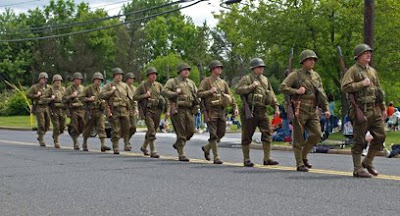A recent letter to the editor in one of the local newspapers called for an increase in public transportation in
Hillsborough and the surrounding area. If you don't drive, or choose not to drive, getting to where you want to go, when you want to go there, is nearly impossible. Regularly scheduled public transportation in the town and between towns would be a great benefit to residents, and a boon to the local economy.
It's hard to imagine now that such a service not only existed once upon a time in central New Jersey but actually flourished. In the late nineteenth century, and well into the age of the automobile, our area was well served by an interconnected network of electrified trolley lines - which today we would call "inter-urban" or 'light-rail".
 |
| Bound Brook Trolley, postcard circa 1910 |
At the turn of the last century, it was said that a person could travel from the east coast to Chicago using only trolleys, and that probably wasn't far from the truth. Somerset and
Middlesex Counties had a number of lines, many converging at New Brunswick. My maternal grandfather, a machinist by trade, worked as a young man in
Dunellen - and many times recounted the days when you could go just about anywhere in Central Jersey by trolley, anytime you pleased.
Literally.
 |
| East Main Street Bound Brook circa 1907 |
On the cold winter evening of January 1
0th, 1902, Mrs. George
Daly, Miss Louise
Daly, and Mrs. Mae
Bellis of Bound Brook, took the trolley to New Brunswick to see the popular playwright Lincoln J. Carter's brand new offering "The Eleventh Hour" at the Shortridge Theatre on Liberty Street. It turns out that the play was prophetically named, as the last trolley car back to Bound Brook left New Brunswick at 11 p.m.
The three women were under the impression that the last car left at midnight, and were bewildered when they exited the theater shortly after 11 and were told that they had missed the last trolley home.
 |
| Lobby card for the 1923 film version of "The Eleventh Hour" |
Instead of looking to hire a carriage for the seven-mile ride to Bound Brook - a two-hour trip - a "strange impulse" led them to seek out the house of Edward
Radel, Secretary of the trolley company, and lay out their grievances.
They rang the bell at the
Radel home at about 12:15. Mr.
Radel, leaning out of the window expecting to hear about some catastrophe on his trolley line, instead was met with the despairing appeals of the women. As The New York Times reported the next day, Mr.
Radel was touched by the plight of the young women, saying, "All right girls; I'll take you home myself. You go down to the traction office and wait for me."
 |
| George Street, New Brunswick, circa 1905 |
Mr.
Radel hurried to the office, retrieved a controller handle to operate the trolley, and made an express run to Bound Brook in record time - acting as motorman and conductor, but collecting no fares from his three passengers. He returned home alone at about 2 a.m.
If we could guarantee that kind of service today, I'd bring back the trolleys in a heartbeat. Unfortunately, I think those days are long gone!

















